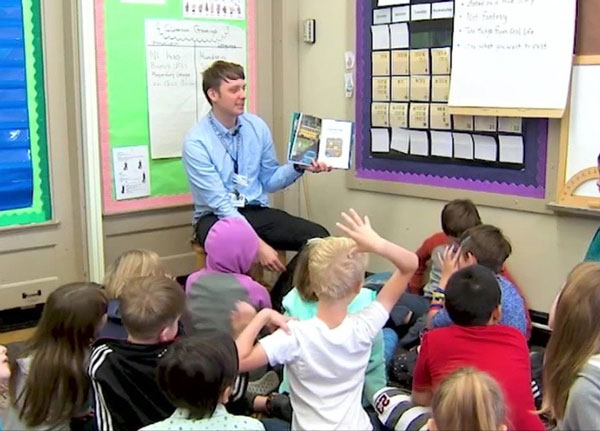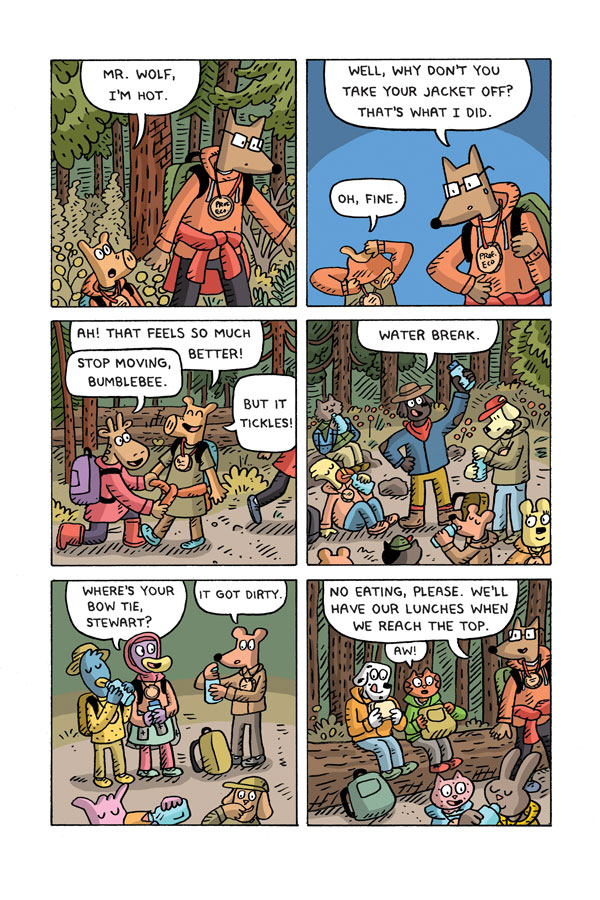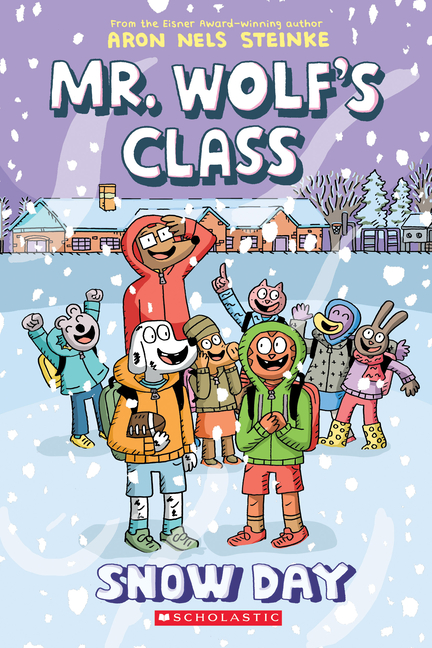From Teaching to Writing

TeachingBooks asks each author or illustrator to reflect on their journey from teaching to writing. Enjoy the following from Aron Nels Steinke.
If I could go back in time and tell my childhood self that I would one day grow up to become a professional writer, I don’t think I’d believe it. And if I told myself that I’d also become a teacher, my head would surely explode.

Being a good teacher is to be tuned-in to and responsive to what kids need at any given moment.
I didn’t like school for all the same reasons anyone might have, and I could never imagine that I’d volunteer to return once I was out. But honestly, I actually really love teaching.
And writing? It’s not that I didn’t like writing when I was a child. I loved inventing characters and stories, but I struggled with spelling, punctuation, and other conventions, and still do to this day. If I could go back in time, I’d tell myself that none of those things really matter. At least not as much as you think they do. I’d tell myself that most writers get help from other writers, and that’s normal. And as a professional, I get help from editors and copy editors who have a much better command of the English language than I do. My books don’t get bad grades just because I need some help.
In the classroom, it’s no different. Kids should be encouraged to ask their classmates for help when they need it. We learn from each other and by example. But not all kids know this. You have to show them that writing is not meant to be done in a silo.
We need to make sure we are listening to what they are interested in and guiding them with that interest in mind.

As a teacher, I believe It’s important for kids to write without the constant interference of adults. We need to hold back the instinct of immediately pointing out every error we see. To kill a young writer’s spirit by immediately pouncing on low-hanging fruit such as writing conventions is a terrible thing. Let them express themselves fully, first. Sure, a little spelling, capitalization, and punctuation advice along the way can be a good thing, as long as it doesn’t interrupt their flow and drive. Being a good teacher is to be tuned-in to and responsive to what kids need at any given moment. Sometimes they need to be left alone. Maybe they need assistive technology, or noise-cancelling headphones. Maybe they need to sit by a friend or by themselves. Maybe they just need to use the bathroom.
Just as many educators understand that children need uninterrupted time for choice reading, kids should be allowed uninterrupted time for choice writing. Give them time to write whatever they want to. They’re tired of always having to consider the teacher’s agenda, district, and state standards. They are missing out on a whole world of self-guided exploration. Grow a community of writers by allowing them to just write, and join that community as a writer yourself.
Write in front of your students. Make mistakes. Be honest. Draft. Think out loud. Get their help. Make it collaborative. Make it fun and find other ways to make writing relative. Write for no other reason than that you just want to. Draw in front of them and give them permission to draw too.
Drawing is a form of literacy. Growing up, I told stories through my drawings. At home I would make elaborate drawings and comics based on characters from television, comics, and games. I’d then bring the drawings to school, hidden from my teacher. I’d have to wait until recess to show my friends, because we weren’t allowed to draw in class. I most certainly wasn’t allowed to read comics in class. I was expected to read “real” books.

In second or third grade, I remember finding a book in the library. On the cover was a picture of a wizard, a wolf, and a sword. Immediately, I knew this book was meant for me. After we returned to class I put the book at the edge of my desk, where it would lie as an outward manifestation of my personality. But when it came time to actually read the book, I had to face reality. The book was intimidating. Hundreds of pages and lots of words I didn’t know. It didn’t take long before I realized I couldn’t read the book, and no amount of time I kept it on the surface of my desk was going to change that fact. I felt incredibly stupid.
We need to make sure kids have books that they are interested in and that they can access. We need to help them make these choices by narrowing the field for them. We need to make sure we are listening to what they are interested in and guiding them with that interest in mind.
If I could have grown up reading Dog Man, Raina Telgemeier’s books, or the Amulet series, I know I would have become a reader much, much sooner. If I had had access to the graphic novels and hybrid books kids have today, maybe I wouldn’t have hated school so much. Or maybe if my teachers had just let me read the comics that did exist, or in the very least helped guide me toward books that were a good fit, I would have found success much sooner.
I became a teacher, in part, to be the kind of teacher I wished I had growing up. Similarly, as an author who makes graphic novels for kids, I am directly rebelling against those adults in my life who didn’t see the value of comics, drawing, or visual literacy. I know most teachers, parents, and librarians today recognize how important comics are, but it hasn’t been that long since attitudes were strikingly different. Reading is reading. And as a teacher and as an author, I get to help kids on their path toward becoming lifelong readers. It’s an honor and a privilege.
Books and Resources

TeachingBooks personalizes connections to books and authors. Enjoy the following on Aron Nels Steinke and the books he’s created.
Listen to Aron Nels Steinke talking with TeachingBooks about the backstory for writing Mr. Wolf’s Class. You can click the player below or experience the recording on TeachingBooks, where you can read along as you listen, and also translate the text to another language.
- Listen to Aron Nels Steinke talk about his name.
- Discover the entire Mr. Wolf’s Class series
- Explore the trailer for Mr. Wolf’s Class
- Discover Aron Nels Steinke’s page and books on TeachingBooks
- Visit Aron Nels Steinke on his website, Twitter, and YouTube.
Explore all of the For Teachers, By Teachers blog posts.
Special thanks to Aron Nels Steinke and Scholastic Books for their support of this post. All text and images are courtesy of Aron Nels Steinke and Scholastic, and may not be used without expressed written consent.



What a great post! I wish all teachers would make the time to read it and apply your ideals. Let them read. Let them write. Love, love, love it.